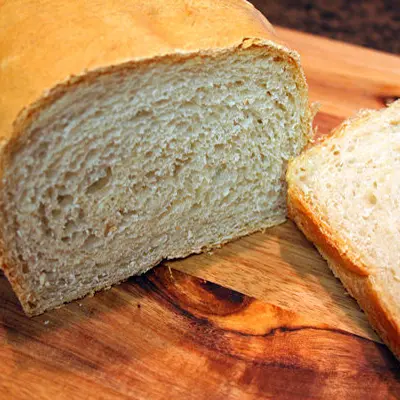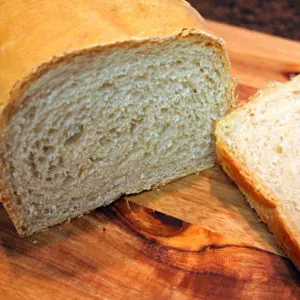This white bread recipe using a simple straight dough method is the simplest method of making kneaded yeast bread. This is an easy homemade white bread to make where all ingredients for the bread, using a straight dough, are combined at the beginning.

[lwptoc hideItems="0"]
White Bread Recipe
The method variations that we followed in the video demonstration are noted below, and will result in a more flavorful bread with just the right amount of crust!
To start, add 4 cups of all-purpose flour to your stand mixer bowl or a large mixing bowl.
Create a well or indent in the flour using the back of your hand/fist or your measuring cup.
Add 1 ½ cups of tepid (neither warm nor cool) water into the center of the well and sprinkle the active dry yeast onto the pooled water.
Allow the yeast to activate for about 10 minutes, add the salt, then mix the ingredients just enough to moisten the flour.
Method #1 Kneading with a stand mixer
(as in video demonstration): Place the bowl on the stand mixer and attach the dough hook.
Mix for two minutes to finish combining ingredients, then cover with a moist towel or plastic wrap and allow to stand for 20 minutes.
Knead the dough on medium speed for 7 minutes or until the dough is smooth, slaps the sides of the bowl, and passes the windowpane test.
Note: I usually knead for 3 minutes, allow the gluten to form for 10 minutes then finish the kneading process.
Method #2 Kneading by hand:
Mix ingredients for 3 minutes then cover with a moist towel, bowl, or plastic wrap and allow to stand for 20 minutes. Knead for about 15 minutes.
Method #3 Kneading with a food processor:
Process for 10 seconds, then cover with a moist towel or plastic wrap and let stand for 20 minutes. Process for 1 minute until the dough forms pellets (the dough will come together in a smooth ball once you pick it up and knead it by hand for a few seconds).
After kneading, cover the dough with either a moist towel or plastic wrap and allow the dough to rise (ferment).
The fastest rise would be allowing the dough to rise at warm room temperature for about 2 hours, the slower rise option is to allow the dough to rise at warm room temperature for 30 minutes but then refrigerate the dough overnight (slowest rise, the resulting bread has better flavor - as in video demonstration).
Punch the dough down by pressing your fingers into the risen dough.
The more you press down, the smaller the air pockets in your bread (for example, pressing down approximately halfway as I did in the video results in smaller air pockets. If I want larger air pockets, as in my french bread loaves, I only press down a quarter of the way).
Working your dough on a floured work surface, dust any remaining wet or sticky spots on the dough with flour.
To form a loaf press dough out into a large rectangle.
Turn the long side of the rectangle toward yourself and roll the dough onto itself creating a smaller loaf-shaped rectangle.
Turn the smooth side down and depress the center of the dough, turning the ends in toward the center.
Turn right side up and place in a greased loaf pan.
Cover the shaped loaf with a moist towel or oiled plastic wrap and allow the dough to rise in a warm place until doubled in size, or about 1-3 hours.
Preheat oven to 425 degrees F (218 degrees C). Before baking, place a baking sheet on the bottom rack and fill to ½ inch depth with hot water then place your loaf pan on the middle rack centered over the baking sheet with water.
Bake for 40-45 minutes or until the internal temperature of the bread loaf is 205 degrees F (96 degrees C).
Allow to cool in the pan for about 10 minutes, then remove the loaf from the pan and finish cooling to room temperature with the bread loaf on a wire cooling rack.
📖 Recipe Card
White Bread Recipe Using Simple Straight Dough
Ingredients
- 4 c (480 g) all-purpose flour
- 1 ½ c (375 ml) water, tepid (neither warm or cool)
- 1 ½ tsp (.15 oz/3 g) active dry yeast
- 1 tsp (2 g) salt
(Note: 2x or 3x only changes the ingredient list)
Instructions
- Put 4 c flour in the stand mixer bowl, creating a well in the center with your hand/fist. Add 1 ½ c tepid water to the well in the flour. Sprinkle 1 ½ teaspoon active dry yeast onto the water surface. Let sit for 10 minutes. Mix ingredients to moisten, add 1 teaspoon salt and stir ingredients together.
- Kneading with stand mixer (as in video demonstration): Place the bowl on the stand mixer and attach dough hook. Mix for two minutes to finish combining ingredients, then cover with a moist towel or plastic wrap and allow to stand for 20 minutes. Knead the dough on medium speed for 7 minutes or until the dough is smooth, slaps the sides of the bowl, and passes the windowpane test. Note: I usually knead for 3 minutes, allow the gluten to form for 10 minutes then finish the kneading process.
- Kneading by hand: Mix ingredients for 3 minutes then cover with a moist towel, bowl or plastic wrap and allow to stand for 20 minutes. Knead for about 15 minutes.
- Kneading with food processor: Process for 10 seconds, then cover with a moist towel or plastic wrap and let stand for 20 minutes. Process for 1 minute until the dough forms pellets (the dough will come together in a smooth ball once you pick it up and knead it by hand for a few seconds).
Fermentation
- Cover the dough with a moist towel or plastic wrap and allow to rise. 2 hours at warm room temperature (fastest rise) or 30 minutes at warm room temperature, then overnight in the refrigerator (slowest rise, resulting bread has better flavor - as in video demonstration).
Shaping
- Punch the dough down by pressing your fingers into the risen dough. The more you press down, the smaller the air pockets in your bread (for example, pressing down approximately half way as I did in the video results in smaller air pockets. If I want larger air pockets, as in my french bread loaves, I only press down a quarter of the way).
- Working your dough on a floured work surface, dust any remaining wet or sticky spots on the dough with flour. To form a loaf press dough out into a large rectangle. Turn long side of the rectangle toward yourself and roll the dough onto itself creating a smaller loaf shaped rectangle. Turn the smooth side down and depress the center of the dough, turning the ends in toward the center. Turn right side up and place in greased loaf pan.
Proofing
- Cover shaped loaf with a moist towel or oiled plastic wrap. Allow to rise in a warm place until doubled in size (1-3 hours).
Baking
- Preheat oven to 425 degrees F (218 degrees C). Before baking, place a baking sheet on the bottom rack and fill to ½ inch depth with hot water.
- Place your loaf pan centered over the baking sheet with water. Bake for 40-45 minutes or until the internal temperature of the bread loaf is 205 degrees F (96 degrees C). Allow to cool on a wire rack.
Nutrition


Elizabeth Pineda says
Helpful to our Home economics 1 baking lessons, Thank you mam Angela@ Bake it with 💕 Love....😊